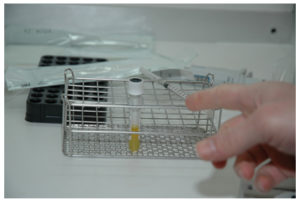Share
 Osteoarthritis in a joint occurs due to loss of the cartilage that covers the bone surfaces. This is as the result of chondrocyte cell death. Many factors ican contribute to this ncluding age, trauma, inflammation and infection.
Osteoarthritis in a joint occurs due to loss of the cartilage that covers the bone surfaces. This is as the result of chondrocyte cell death. Many factors ican contribute to this ncluding age, trauma, inflammation and infection.
There is a lot of research being undertaken to find ways to prevent or slow this process. An increasingly fashionable treatment is the injection of Platelet-rich plasma (PRP) into an osteoarthritic joint.
Platelet-rich plasma (PRP), is a blood derivative that has a higher platelet concentrate than whole blood. The test tube in the photo is what it looks like after the red and white cells have been removed from the blood. This mixture is then “activated” causing the platelets to release a group of biologically active proteins that bind to the transmembrane receptors of their target cells, thus leading to the expression of gene sequences that ultimately promote cellular recruitment, growth, and morphogenesis, and modulating inflammation as well. That is the theory.
A review article summarises all the recent research. Platelet-rich plasma: why intra-articular? A systematic review of preclinical studies and clinical evidence on PRP for joint degeneration.
The bottom line conculsion is……
” With the limits of a complex field still in its infancy, few studies and some controversial results, this systematic review still showed some important aspects. The first one is that the increasing interest in this topic is being translated into research with a growing number of papers published over time, which show promise in shedding some more light on PRP use in the near future. The second one is that, besides the limits and sometimes controversial findings of in vitro and animal studies, the preclinical literature documented an overall support toward PRP application for the injective treatment of cartilage lesions and OA. Moreover, some conclusions can be drawn also with regard to human application, which can be of clinical usefulness. The first one is the safety of PRP injections, with no major adverse events reported in the literature and only some reports of self-limiting immediate pain and swelling reaction [17 ]. The second one is that all studies seem to agree on an overall clinical benefit of PRP. Better results with respect to saline have been shown, and some studies suggest a slight superiority of PRP with respect to visco supplementation [8 ]. However, not all patient categories present the same results that are more significant in younger patients affected by not too advanced degeneration, and the clinical benefit is limited over time and can roughly be estimated at less than 1 year [13 ]. This might suggest that this treatment could be applied in cycles to ensure longer lasting results and postpone more invasive procedures. Finally, another aspect emerges from the literature analysis: whereas among the available techniques none clearly seemed to offer superior clinical results [17 ], it appears clear that there is room for a better targeting of this PRP application. Several aspects still need to be studied to understand the mechanism of action of PRP and give better treatment indications and possibly to optimize the procedure and improve the potential of this biological minimally invasive approach for the treatment of cartilage degeneration and OA.”
@
For the full article and references see the link. http://www.ncbi.nlm.nih.gov/pmc/articles/PMC4541701/P
Platelet-rich plasma: why intra-articular? A systematic review of preclinical studies and clinical evidence on PRP for joint degeneration
Knee Surg Sports Traumatol Arthrosc. 2015; 23(9): 2459–2474.
G. Filardo, E. Kon , A. Roffi , M. L. Merli , and M. Marcacci
